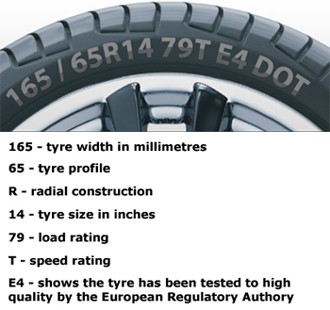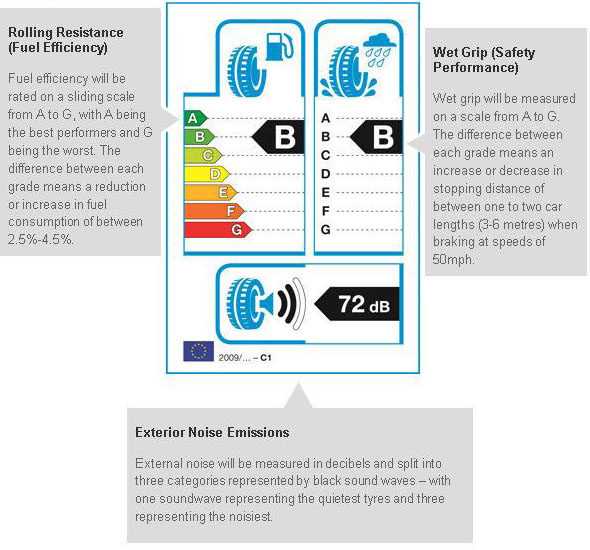
Tyre Wall Markings
The lettering and numbers on the tyre's wall are a code which gives you precise information on the tyre's exact specification. Using the diagram, right, all is explained.
Tyre Width: the width of the tyre in millimetres.
Tyre Profile: is the height of the tyre sidewall as a percentage of the width. This is also known as the aspect ratio.
Tyre Construction (R): the tyre has a radial construction. Most tyres use a radial construction, and most cars are best suited to radial tyres.
You can also get cross ply and bias belted tyres, although these are quickly becoming redundant.
You should never mix these different types of tyres on the same axle i.e. have both cross ply and radial at the front. Legally, you could have radial at the front and cross-plys at the back (or vice versa) but it isn't recommended that you do so.
Tyre Size: the diameter of the tyre's inner rim in inches.
Load Rating: this signifies the maximum weight the tyre can safely carry. The higher the number, the higher the weight the tyre can carry. Your car's manual will give you the correct load rating for your car or your can enter your car details at any online tyre retailer. If you get this wrong, your car insurance can become invalid. When replacing a tyre, don't assume the load rating for the tyre already on the car has the correct load rating.
Speed Rating: this indicates the maximum speed for the tyre when the vehicle is at full load.
Generally, maximum tyre speed is rated in alphabetical order. However, W and Y rated tyres are a special case as they can operate at higher maximum speeds than older Z rated tyres. It is therefore safe to replace your current Z rated tyres with W or Y rated tyres. See the table on the right for a full list of ratings.
Again, using tyres with the wrong speed rating can invalidate your car insurance so you must check for the correct speed rating, using your car's manual or on online checker.
Fitting a tyre with a speed rating higher than the original tyre, will not necessarily give any benefit or improvement to performance or handling.
| Symbol | Max speed | Max speed |
| M | 81 mph | 130 km/h |
| P | 93 mph | 150 km/h |
| Q | 99 mph | 160 km/h |
| R | 106 mph | 170 km/h |
| S | 112 mph | 180 km/h |
| T | 118 mph | 190 km/h |
| H | 130 mph | 210 k/ph |
| V | 150 mph | 240 km/h |
| W | 169 mph | 270 km/h |
| Y | 187 mph | 300 km/h |
| ZR | 150+ mph | 240+ km/h |
E4: ECE approval mark. This means that the tyre has been tested to a high standard by the European Regulatory Authorities. Not all tyres will have this mark.
All Season Tyres
These are a general purpose tyre and are the tyres that most cars run on. They are designed to give good performance in the widest of weather conditions, a jack-of-all-trades but a master of none. Once the temperature falls below 7C their ability to grip the road diminishes as the molecules in the tread rubber harden and eventually freeze, which makes your tyres much less adaptable to the road surface, reducing grip levels.
Winter Tyres
A specialist tyre used for cold weather conditions. Unlike all season tyres, the molecules in the tread rubber don't so readily harden when exposed to cold temperatures, so grip is maintained for longer.
Such tyres perform much better on snow and ice, and even when the road is just cold or wet. In fact, the temperature only has to fall below 7C for winter tyres to out perform all season tyres. It has even been claimed that, due to the British climate, it would be wiser for most motorists to use winter tyres throughout the year.
In countries with colder climates or just more serve winters, it is commonplace, and even a legal requirement, for motorists to switch to winter tyres in the winter and back to summer or general purpose tyres come the summer.
Self Supporting Run Flat Tyres
These allow you to drive for a up to 50 miles, at a speed of no more than 50mph, with a puncture. They have a tyre wall marking of RF.
You can't fit runflat tyres to just any car. They car must have a tyre pressure monitoring system installed, as this will tell the driver when a puncture occurs.
Choosing Tyres
As with most things, you get what you pay for. The better quality the tyre the longer it is likely to last, it is also likely to offer better performance. However, fitting an expensive high-performance tyre to a Ford Fiesta is pointless, as such a car will never take the tyre to the limits of its performance.
Remoulds - these are usually the cheapest tyres you can buy. They are made from old tyres whose tread is worn-out but whose basic structure is still sound. In the majority of cases remould tyres perform satisfactorily provided the manufacturers guidance about maximum vehicle loadings and maximum speeds is followed.
A remoulded tyre should display the word 'remould' on the tyre wall.
Tread Pattern - there are a number of tread patterns to choice from. Some designed to perform best in the wet, other to be more fuel efficient. Which you choose will depend on your own specific requirements, however,
Replacing Tyres
It can be argued that you it is best to replace all four tyres at once. However, this isn't always needed or even practical to do so. However, try to replace a pair of tyres, front or rear, at the same time, as this will give you optimum handling and grip on each axle.
Avoid Damage and Danger
New EU Tyre Labelling
From November 2012 all tyres on sale in the UK will need to display a new label system displayed at the point of sale. The labels are designed to provided accurate information on the tyres wet grip, fuel efficiency and exterior rolling noise. Tyre manufacturers will also have to make this information available to customers through technical promotional material and their websites.
Rolling Resistance
This measures how fuel efficient the tyre is. A tyre with rating A requires less fuel to propel a car along than a tyre rated G.
Wet Grip
Measures a tyre’s ability to stop a vehicle on wet roads, expressed in terms of distance. The difference between each grade means an increase or decrease in stopping distance of between one to two car lengths when using maximum braking from 50mph against a reference tyre.
Noise
This is the external noise made by the tyre, measured in decibels. The more black bars shown on the label, the louder the tyre.
